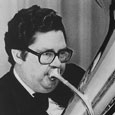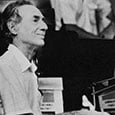 Harvey Phillips was born on December 2, 1929 in Aurora, Missouri and died October 20 after a long illness. Phillips was steered toward the tuba by his high school band director and played briefly with the King Brothers Circus. He spent a semester at the University of Missouri, but then went to play with the Ringling Brothers and Barnum & Bailey Circus, where he stayed for three years. William Bell offered him a scholarship at Juilliard, and Harvey took it. From 1971-1994 Phillips taught at Indiana University. He is perhaps best known for founding TubaChristmas.
Harvey Phillips was born on December 2, 1929 in Aurora, Missouri and died October 20 after a long illness. Phillips was steered toward the tuba by his high school band director and played briefly with the King Brothers Circus. He spent a semester at the University of Missouri, but then went to play with the Ringling Brothers and Barnum & Bailey Circus, where he stayed for three years. William Bell offered him a scholarship at Juilliard, and Harvey took it. From 1971-1994 Phillips taught at Indiana University. He is perhaps best known for founding TubaChristmas.
Editor’s note: These are excerpts from articles printed in The Instrumentalist, and in some paragraphs have been rearranged.
The Story Behind Octubafest and TubaChristmas by David Lewis (December 1988)
What inspired you to conceive TubaChristmas?
I was inspired by the fact that William Bell, a prime mentor and inspiration for tubists and euphoniumists, and indeed to all who knew him, was born on Christmas Day, 1902. In November 1974 I was searching for an idea to formulate an event honoring William Bell – and through him, all those great people and performers who represent our heritage, people to whom we will forever be indebted. I recalled that as a student of Bell’s I first visited his home on Christmas Day in 1949. I remembered that December 25 was his birthday, and I then formulated the concept of a mass tuba-euphonium ensemble performing Christmas carols. New York City was the obvious choice, because Bell spent most of his professional life there. Of course any thought of New York City and Christmastime leads to the great Christmas tree and holiday setting of the ice rink at Rockefeller Plaza.
The public relations staff at Rockefeller Plaza was a bit apprehensive at first about a mass tuba ensemble, but with the help of friends I secured the site of the ice rink stage directly under the great Christmas tree for Sunday, December 22. I contacted Paul Lavalle [former conductor of N.B.C.’s Band of America] to conduct the concert. I distributed hundreds of flyers announcing the concert, sending them to professional players and college and high school music educators in the greater New York City area. We expected an ensemble of 300 and on the day of the concert we assembled over 320 players. Over Thanksgiving weekend I called my dear friend, Alec Wilder, and asked him to arrange Christmas carols for the group. Overnight he arranged 19 carols; by December 3rd I had the scores from his copyist. I decided to give a benefit concert in Bloomington as a warm-up for New York and chose the burned children’s fund of the Firemen’s Auxiliary as a good cause. Talking with one of my graduate students we decided that we would attract much more attention and contributions if we wore Santa Claus suits. We managed to come up with 24 Santa suits from rental companies and arrange for the Bloomington Fire Department to transport us downtown and to a local shopping mall to perform. In this way we benefitted the Fireman’s Auxiliary, tested the audience response to our ensemble, and had some good fun.
Tell us about the first TubaChristmas.
The day of the first performance we rehearsed in the hallway of N.B.C.’s studio, which was about 14 feet wide and 200 feet long. After stuffing the space with euphoniums up front and the tubas and sousaphones in the rear we suffered the cacophony of warming up. Visitors from the press and news media were predictably unimpressed; even some of my devoted friends had expressions that said, “You’ve really done it this time, Harvey.” Things looked a little brighter after we tuned; then Paul achieved silence (a miracle) and announced that we would commence the rehearsal with “Adeste Fidelis” (“O Come All Ye Faithful”). Paul gave a sweeping upbeat and on his downbeat 320 euphoniums and tubas started to play. In such a confined space the sound was so beautiful and overwhelming that some listeners burst into tears.
We had a surprise when we got ready to give the performance. The Rockefeller Center people had arranged for all those euphoniums, tubas, and sousaphones to proceed single file through a closed-down restaurant and enter into the rink through a revolving door. There are two restaurants at either end of the rink where people dine and observe the serene scene of graceful skaters and the great Christmas tree. Well, I watched the revolving door, helping each player through one at a time, making certain their instruments weren’t damaged. I saw a woman having dinner with her family and I could just imagine her conversation: “Oh, look, there’s a tuba.” Then when it got to be about 20 tubas, everyone in the restaurant got up and came to the window. We still had 300 to go! This first New York TubaChristmas received incredible media coverage.
What keeps TubaChristmas fresh for you?
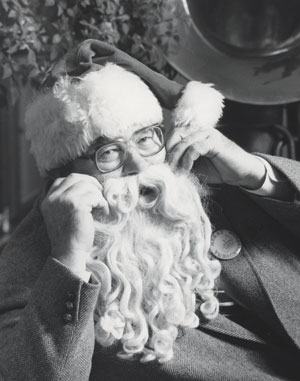 The great thing for me is to see a nine-year-old player standing next to a tubist from the symphony orchestra, next to a 75-year-old enthusiast, all surrounded by college players. Performers learn about the traditions of our instruments, and at the same time they share those experiences with the general public, gaining respect and acceptance for the instruments.
The great thing for me is to see a nine-year-old player standing next to a tubist from the symphony orchestra, next to a 75-year-old enthusiast, all surrounded by college players. Performers learn about the traditions of our instruments, and at the same time they share those experiences with the general public, gaining respect and acceptance for the instruments.
William Bell and Alec Wilder played such an important role in my life and were such influences on me that I look upon TubaChristmas as almost a religious experience every time I participate.
Preparing for a Life in Music:
An Interview with Harvey Phillips
by Bernard Dobroski (June 1991)
Many people have excelled on their instrument; others have become accomplished teachers, and a smaller number have done both. Few, though, have elevated their instrument from relative obscurity through their conduct and force of will. Because of Harvey Phillips the tuba has achieved a high level of excellence and respectability. His address book lists an impressive diversity of musicians, all of whom are willing to take his calls.
How do you guide a student who wants a career in music?
I encourage students to become experts in self-analysis. Every day they should analyze their present level of achievement and their potential in music, and not just as performers. Students learn about themselves by comparing their achievements to those of colleagues. A student may discover that others have achieved a superior technique that he can never achieve, no matter how hard he tries. However, he may have a great personality and be someone in whom others have confidence. This student should think about other areas of music in which he could become successful. I try to assess my students regularly to determine their strengths and weaknesses as well as their potential. I want students to talk with me about observations of themselves. By the time they are juniors and are more mature as people and musicians, we can plan for their musical futures and discuss their strengths. Everyone has a closet full of weaknesses, to be opened when no one else is around, and each should take the time to turn them into strengths. I don’t want students to become artistic robots, but human beings who are aware of their own strengths, weaknesses, and the needs of others.
I don’t know anyone in music who is involved in only one aspect of it. Most successful careers combine several aspects of music that draw on particular merits and abilities. Talent alone will never make a great musician. A great talent can be wasted without the investment of time, but a lesser talent who diligently puts in time can rise above more talented colleagues.
What do you teach in private lessons?
The first thing I ask a student to play is a given scale, two octaves ascending and descending. I may ask for a whole tone scale, one of the modes, a major or minor scale in one of the three forms, or a chromatic scale. I’m concerned with his reflex knowledge of the scale patterns because this shows his innate musicality. A thinking player is aware of the position of the half-and whole-steps in each scale and mode.
Almost every lesson includes music that is lyrical, technical, and I always include a study that explores range. The amount of time we spend on any of these areas depends on the student’s needs.
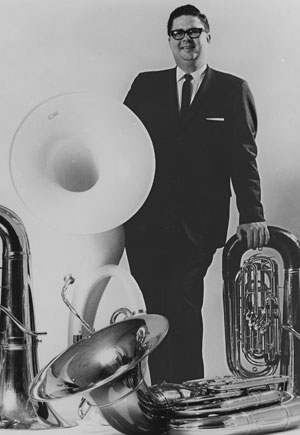
To prepare for your lessons, do students have to develop answers to questions in these areas?
Musical maturity is the important thing for students to achieve, and precious few do – to be able to walk out on stage and play a Handel sonata, a Strauss tone poem, or a Brahms symphony and feel no remorse after the performance. With musical maturity they may play it differently every time but remain confident in themselves. That’s when someone may walk up to them and say, “I’ve never heard that interpretation before; it’s fantastic. I feel I’ve heard this music for the first time.” When my students play for me, I want to know why they choose their interpretation; it doesn’t matter whether I think it’s great or rotten.
Bud Herseth broke the bounds of tradition and gave his interpretations of trumpet parts. He is such a genius as a musician that he is a hero. Another trumpet player who had that quality was Harry Glanz; there are others who are so secure with their own musicality that they never worry about their interpretations of any composer. That’s something every young player should aspire to. The most important thing I aspire to is giving students self-reliance.
Why did you choose the tuba as your instrument?
The tuba was selected for me. I grew up in a very small high school; between grades one and twelve we had just over 400 students, so you can imagine what our high school band was like. I took my father’s violin to school and tried to play along with the band. In 1942, shortly after we entered World War II, our band’s only Sousaphone player joined the Navy, and my high school band director asked me to play Sousaphone. That was one of the most wonderful things that ever happened to me. The tuba became my constant companion; I took it everywhere with me. I worked at a funeral home before school every day and even took it there. I rode my bicycle with the tuba; if I was riding into the wind I’d put the bell in so the wind went straight over it. While riding away from the wind I used the bell to tack like a sailboat.
My high school band director talked me through the fingerings because I didn’t have a fingering chart; my method book was a hymnal. In every free moment I sat at the piano and played hymns on the Sousaphone. My mother was often in the kitchen when I practiced and sang along. If I hit a clinker, she came in to make sure I knew it was a clinker. Because of her singing I paid attention to the words in the hymnal and became aware of how words influence phrasing. I ask my students to play lyrical melodies, popular songs, and hymns to develop phrasing. Students who do not develop a personal style to their phrasing are mimics of what they hear and what their teachers tell them. When people ask me why anyone plays the tuba, I usually think, why not? Those who say the tuba takes a lot of air, I ask if they had to spend the rest of their lives breathing through a straw, would they choose a small straw or a big straw?
Did you study with a private teacher?
I didn’t study with anyone until I studied with George C. Wilson at the University of Missouri, where I attended classes only one semester. Before I entered Juilliard, I worked professionally for three years traveling with the Ringling Bros. Barnum and Bailey Circus Band and played with Johnny Evans, a great artist of the tuba and a former member of the Sousa Band. Sitting next to him was like taking six hours of private lessons every day. That was my apprenticeship, and my major study was with William Bell. He was my primary influence.
What teaching problem is the most difficult?
Overcoming a student’s bad habits, often developed because of the inattention of a teacher or director. A brass player’s worst habit is puffing the cheeks; the next is pulling back the corners of the mouth when playing in the high register. These habits go hand-in-hand and are almost impossible to break. Sometimes making a student aware of what holds him back in developing range or uniform sound is the best I can do. While puffing his cheeks, he sounds like one player; when pulling his cheeks in, he sounds like another. Once a student is aware of the results from a change, he usually will pull through. If a student has a good sound in all registers I will accept that he alters his physical approach to the instrument to achieve a consistent sound in different registers. I don’t expect any two players to play exactly the same way.
Where will all the students in our conservatories and schools of music find careers?
For every one of them there can be a life in music. If they want a life in medicine, law, or engineering but still want to be involved in music, it can be a great sideline that enhances their lives. Musicians who make their careers in music benefit from the support and interest of the audience, many of whom have avocations in music. There are no losers. It is immoral to tell every student he has the potential to be a major orchestral player; there should be honesty. I don’t see how anyone can teach applied students without feeling involved with their lives. I hear from students who studied with me 25 or 30 years ago who want advice or want to tell me about a recent accomplishment. There is no greater enjoyment than the pleasure and fulfillment music brings to our lives.
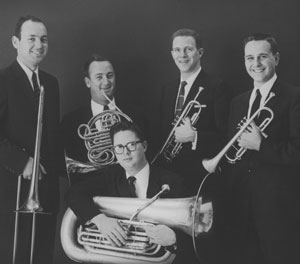
Goodbye Oompah: A Profile of Harvey Phillips by Whitney Balliett (August 1994)
The ongoing elevation of the tuba from the laughingstock of musical instruments to one of its kings is mainly the doing of Harvey Phillips, a tubist and professor of music at Indiana University, who has spent over half his life in the service of his instrument, which he plays better than anyone else in the world. (Tubists are multiplying in direct ratio to their repertory; there are now nearly a thousand members of the T.U.B.A. – the Tubists Universal Brotherhood Association, an organization Phillips helped get on its feet.)
* * *
[Phillips] “I graduated from high school in Marionville, Missouri, in 1947, and I got a summer job playing tuba with the King Brothers Circus. This came about through Homer Lee, who taught music at my high school and had got me started on the sousaphone. He looked like Ichabod Crane and was a retired circus bandleader. When the word reached our Methodist preacher that I was joining a circus, he came out to our house and Mother received him in the parlor. ‘That boy will be destroyed if he works in a circus,’ he said to my mother.. “Circuses are full of the wicked and degenerate. He will be lost.’ Tears came to my mother’s eyes, and she said, ‘You don’t have much faith in Harvey, do you Reverend? Well, I do,’ and she showed him to the door.
“After nine weeks, I left to go to the University of Missouri, where I had a scholarship. I was miserable there. I slept in a rickety bunk in a basement with a local boy, and I carried my room and board by raking leaves and stoking the furnace and cleaning the house. I had eighteen hours of subjects and worked nights at the School of Music. Then a telegram came from Merle Evans, the leader of the band with Ringling Brothers and Barnum & Bailey Circus. He offered me a job on tuba at eighty-seven fifty a week, and I was to go to Sarasota right away if I was interested. Well, I called Homer Lee, and he said immediately, ‘Harvey, get down there with Merle.’ They knew each other, and, of course, to Homer, Ringling Brothers was it. So I closed up at the university and went.
“It was some different from the King Brothers. Ringling had a thousand or so on the payroll. The band traveled in its own railroad car, with a porter and a kitchen and clean sheets every week. Merle had his own stateroom. Johnny Evans, who was no relation to Merle, was the tuba player, and sitting beside him every day was a free lesson. I think the greatest compliment I ever received was after I’d been with the band six months and one of the trumpet players said, ‘Harvey, I couldn’t tell whether it was you or Johnny playing tonight.’
“I stayed with Ringling Brothers for three years until 1950, and I’d be there still if I hadn’t got a wire from Bill Bell when we were playing in Los Angeles. It said I had a full scholarship at Juilliard. This was the second time someone had grabbed my shoulders and turned me around and given me a push in the direction I was supposed to go in. I went to New York, and I was in Juilliard off and on for four years. I lived for a while in Bill Bell’s studio, on 121st street, in a back room with a man named Eric Hauser. He was a fine horn player, or had been until he became an alcoholic. He’d sit on his bed and criticize everything I played. I learned that way, and I learned from playing duets with Bill Bell and going to rehearsals and record dates with him. In 1953, I joined the Sauter-Finegan band for about six months. It knocked me out with its fantastic arrangements and crazy instrumentation. Then I started with the New York City Opera and the New York City Ballet, and, except for a fine two-year stint in the U.S. Army Field Band, I stayed on the New York scene, working twenty-four hours a day, until I joined Gunther Schuller in Boston and had to commute to keep my hand in.”
In 1974, Phillips decided that New York was ready for the tuba, and he organized two extraordinary events. The first was a concert of Christmas carols in Rockefeller Plaza, in front of the big tree, by 250 tubists who had come, at Phillips’s invitation, from all over the country at their own expense. A couple of dozen carols had been freshly scored by Alec Wilder in four- and six-part harmony, and the massed sounds were unique and stirring and noble – so much so that the concert, by 400 tubists, will be repeated this year on December 12.
His second New York event took place early in January of this year. He rented Carnegie Recital Hall for four evenings and an afternoon, and gave five marathon tuba recitals, during which he played thirty-nine pieces. During the eleven days the recitals involved, Phillips rehearsed sixty-six hours, and on two days he did his old New York-Boston-New York shuttle act. Not only did his lip survive seventy-six hours of playing, but immediately after the concert he went to the Roosevelt Hotel, where he performed the Baker tuba-and-string-quartet piece again for a conference of brass men. The next day, he drove Carol and the children through a blizzard to record Schuller’s Capriccio. And the day after, he recorded the Vaughan Williams Concerto.
Phillips is over six feet and of considerable girth. His fingers are sausages and his feet gunboats. He has a long, full face and wavy black hair, and he wears glasses. His cherubic lips bear the pinkish aureole that is the unmistakable badge of the professional brass player. He has an old-fashioned, almost goody-goody look. But his deep-set eyes are savvy and laughing, and his generally placid exterior conceals a mischievous intelligence. Phillips is celebrated for his outsize ways, for his studied chaos, but his excesses – harmless except when the exhaustion they lead to topples him and he goes down like a sequoia – are positive and even altruistic.
Phillips refuses to be separated from his family for any length of time. He and Carol went everywhere together during the childless years of their marriage, and after he was injured in an automobile collision in New York she carried his tuba to every gig for six months. Nowadays, when an engagement keeps him away for more than five days Carol and the children join him, no matter the time of year. On the way home, Carol drives and he sits in the back and practices.
Most tubas engulf their players, but Phillips holds his so that it looks no bigger than a flugelhorn or a French horn. He rests it easily on the right thigh, its bell up, and he secures it with his left hand, which he flops casually over the top tubing. He plays effortlessly, and the only indication that he is maintaining breath support is the sharp, windy intakes of air at the end of his capricious phrases. He is a magisterial yet invariably accessible player. At slow tempos, his timbre is soft and smoky, and somewhat like Tommy Dorsey’s trombone, which is held in high esteem by brass men. At greater speeds, his playing hardens in a muscular, singing way, but he is never brittle. His tone is light and direct, whether he is hitting a C above middle C or whether he is rummaging in the huge lower register – an area where the finest tubist can grope, his candle blown out by his own bearish notes. Phillips’s sound is unique. His tuba suggests a graceful trombone, or a horn minus its nasal quality, or a baritone saxophone of the most velvet persuasion. His technique is astonishing. His arpeggios are glassy and clean, the alarming intervals he sometimes has to play are deft and exact, and his staccato passages are cream. Most of the composers who write for him purposely include passages of such complexity that it is possible no other tubist could maneuver them.
According to James T. Maher, “Harvey Phillips belongs in the American school of wind playing. The English school – Brain, Kell, and the like – has its elegance, its sense of ensemble; the American school has more sinew, even a little roughness. The players in the American school take incredible chances, despite the terrific problems wind instruments inherently have. Harvey has uncanny phrasing, which is not the right word. It makes him sound too technical. What he does is point up the poetry in what he plays. And he is apt to play anything, since there is really no longer a sharp division between jazz wind players and classical wind players and the like. Wind players now move in a great gray area, in which the best are apt to play a different kind of music every day of the week. It doesn’t matter if it’s a T.V. commercial or a recital or a jazz date or movie music, but it does matter how well they execute. Harvey wants to be the best tubist there is, and he wants to shape a new world of sensibility in all music. He keeps a pleasant demeanor, but he’s tough and he’s obsessive. Along with all the order he professes to exhibit, he likes a little bit of daily chaos. Then he has something on which to demonstrate his ability to impose order.”
[Phillips] “The tuba is at the tonal bottom of the brass ladder. At the top is the trumpet, then comes the French horn, which it not French and should simply be called a horn. The trombone is next, and then the tuba. Each rung has its subdivisions. There are piccolo trumpets, F trumpets, cornets, Bb trumpets, C trumpets, and bass trumpets. There are F tubas, Eb tubas, CC tubas, and double Bb tubas. The breathing for singing is parallel to the breathing for brass instruments. One must have breath support, and breath support is being able to maintain a full volume of air in your lungs without coughing or exhaling. Breath control – what you do with the air when you release it – is the key to artistic execution. But there can be no breath control without breath support. In one way, the tuba is the most comfortable of the brass instruments, because it has the largest mouthpiece. In another way, it is the most difficult because one has to move so much air. It’s extremely hard to play a C above middle C, and it’s equally difficult at the low end of the instrument. You have to constantly clarify the tones down there. You can’t just hope the right note will come out. A lot of tubists have no sense of control; they let their lips flop around inside the mouthpiece. The tuba has, after all, two main parts – one is flesh and the other metal. All the metal part can do is accommodate the flesh. If you play a beautiful phrase, the tuba will amplify it. If you play a bad one, the tuba will amplify it.
